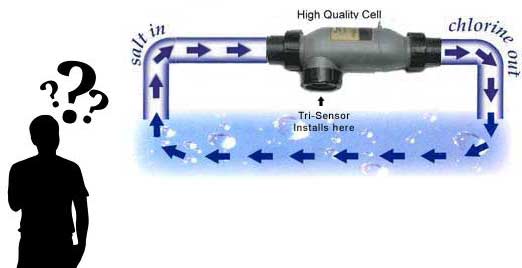 Here are some tips to help ensure your salt systems achieve peak performance
Here are some tips to help ensure your salt systems achieve peak performance
Homeowners nationwide are embracing the convenience of salt pools, but these systems still need to be Monitored by trained technicians. The most common problem — increased scaling requires chemical adjustments and old-fashioned elbow grease. In the mean time, a routine check of the salt cell will uncover most other snags. Even less frequent byproducts of salt pools, such as corroded decks and equipment, come with relatively simple solutions. The key lies in knowing what you’re up against.
Scaling in the ECG
Salt-chlorinated pools are vulnerable to scale formation for two main reasons. First, in an electrolytic chlorine generator (ECG), electricity is created by a negative electrode called an anode and a positive electrode called a cathode; the chemical reactions around the cathode produce sodium hydroxide (a strong base) as a byproduct of the electrolytic chlorine generation process, and this leads to scaling on the cathode. Second, not all salt added to pools is 100 percent pure. Within the ECG, tiny chemical impurities in the salt can break down into byproducts, such as orthophosphates, which provide food for algae and can contribute to scaling. Many units come with indicator lights that notify you when it’s time to check the salt cell for excessive scaling. To rid the cell of calcium deposits, use a solution that’s one part acid and either two or three parts water. Others may opt for a weaker solution. For heavy calcification, experts recommend spraying the cells with water from a hose, to dislodge any scale or debris. In the most extreme cases, multiple acid washes and an overnight soak may be necessary; but this practice risks damage to the cells, so use it only as a last resort.
Water balance
Weekly doses of muriatic acid are necessary to keep the water’s pH in balance, and to prevent surface scaling. A chelating agent also may help prevent calcium from coming out of solution.
Cloudy water and scaling are telltale signs of high pH and TA levels. If you detect these symptoms, you’ll want to first return alkalinity to its proper range of 80- to 120 ppm. Add muriatic acid or sodium
bisulfate to lower the total alkalinity. The higher the TA levels, the more difficult it becomes to change pH. (Remember, pH greatly varies when TA is low.) Once an ideal TA level has been reached, consider keeping an artificially low pH level of 7.2 to compensate for pH rise until your next service call. A regular dose of muriatic acid should keep pH and total alkalinity levels in check.
Calcium hardness
Ideal calcium hardness levels are between 200-400 ppm. Higher levels mean more calcium is likely leaving the solution, which will increase scaling — especially in the ECG. To lower the calcium levels, simply dilute the water. Also, consider adding a chelating agent to combat high hardness. This chemical will bond to the calcium and keep it in solution, adding another layer of protection. However, if the pool is already showing calcium deposits, it’s probably time to deploy the brush.
Salt check
Several systems display salt levels via a digital readout. However, these readings measure salt content by the amount of electrical conductivity of the water, and the water’s temperature. As a result, you’ll never learn the actual number of chloride ions present. Outside interference can affect the water’s conductivity and produce false readings, too. That’s why it’s encouraged to verify the system’s reading with an independent salinity test. You may also use a test strip, titration test or electronic meter for salt.